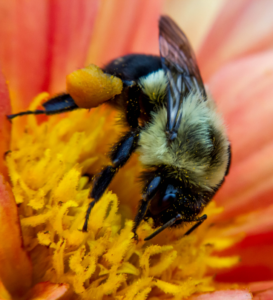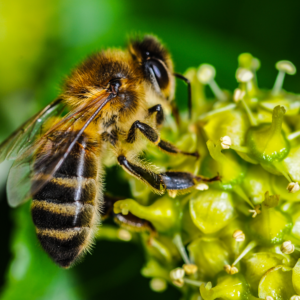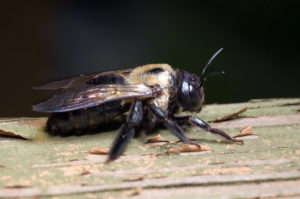Want to get rid of bees but afraid they’ll sting you?
Don’t worry, we’ve got you covered. In this article, we will go over six different ways you can get rid of bees safely. So you can get your home back.
Let’s get started!
1. Identify Bee Type
The first thing you have to do to get rid of bee infestations is to know your enemy.
Identifying the bees will help you decide where to look for the nest.
This will also determine the potential severity of the infestation.
Find out first if you have bees or wasps before taking the next steps. Bees and wasps have distinct differences.
Types of bees
1. Bumble bees
Bumble bees construct their hives on the ground, trees and houses.

- Grow to ½” to 1”
- Have hairs all over their bodies
- Their vibrating bodies make their signature buzzing noise
- Smaller colonies from 50 to 400 bees.
- Can sting multiple times
2. Honey Bees
Honey bees tend to stay within 100 ft of their nest.
These bees are the largest producers of honey compared to any other species.
They are commonly kept by farmers and producers for honey.

Honey Bee Characteristics:
- ½” long
- Large colonies – thousands of bees
- All workers and queens have stingers
- Small body compared to other bees
- Thick hair on abdomen
3. Carpenter Bees

Carpenter bees are one of the most destructive bees. They are known for burrowing into wood and building their nest 6” to 4 feet deep.
These bees prefer soft wood for building their nests.
Carpenter Bee characteristics:
- They can grow up to 1” in length
- They have a metallic reflection on body – ranging from blue, yellow, green, or purple tints
2. Use Bee Catchers
Bee catchers are a great method for removing bees that have not created a nest near or around your home.
They are an effective, albeit temporary, method of getting rid of bees.
Using bee catchers is also a great way of identifying the bee you have. Use it to help you capture a bee so you can inspect it closely.
[amazon box=”B078HSHQR3,B07CQVW67B” grid=”2″]3. Relocate the Hive
Relocating the hive is the most sustainable option for getting rid of bees around your home.
Due to the importance of bees to the ecosystem, it’s important that you avoid killing them.
If you are looking to relocate a beehive, I highly recommend that you hire trained professionals.
This is a dangerous task that you should not do on your own.
When you call a professional, it’s important to verify that they offer hive relocation and not just hive removal.
You don’t want some pest control company coming to your home and using insecticide to kill the bees and then only telling you afterward.
Confirm their method first to avoid any confusion.
4. Insecticide/Bee sprays
Insecticide sprays will kill the bees in your yard on contact.
Be cautious when using bee spray because it can upset the hive and cause them to swarm.
Certain species of bees are dangerous and will attack anything in the vicinity.
When applying bee spray, make sure you wear the proper protection.
You can purchase disposable bee protection suits for under $50. This is a worthwhile investment to ensure that you are safe at all times when getting rid of bees.
I recommend opting for commercial bee sprays, which come in aerosol cans that shoot foam.
These sprays will cover the entire nest and the bees with insecticide.
They are intended to reach large distances and allow you to spray bees at a safe distance.
You can also opt to use professional insecticides, which are more potent. For these, you’ll need to be closer to the hive for proper treatment.
Remember, insecticide sprays should be used as a final option.
Bee sprays using dangerous chemicals will eliminate the hive and any bees inside the nest.
[amazon box=”B0784WG4FD,B003FKTDXW” grid=”2″]5. Repellents
Repellents will drive bees away and prevent them from starting a nest around your home.
These sprays will allow you to keep bees away without killing them or hurting any other insects in the process.
For this, you can either use a natural repellent or a chemical repellent.
Essential oils and citronella candles are effective natural repellents against bees.
The downside of these natural options is that they do not provide long-lasting protection.
For long-lasting protection, you are better off using chemical repellents.
One of the most effective repellents is Bifen I/T. This insecticide is used to repel a variety of insects ranging from mosquitos, cockroaches, even bees.
You can apply Bifen I/T to plants or around the border of your home to create a barrier and repel bees.
To apply this safely and effectively, I recommend using a pressurized sprayer. Apply it to any areas where bees might try to establish a nest or where bees have established nests in the past.
[amazon box=”B07S3Q4PWP,B07G5X61LP” grid=”2″]6. Dusting
Dusting is one of the most effective ways to treat beehives. They are not a solution for bee swarms.
For dust treatments, you can use Diatomaceous Earth, Boric Acrid, or Delta dust.
These powders are designed to kill insects by either dehydrating them or by attacking their nervous system.
For the best results, I recommend using a dusting bulb when applying dust to a hive.
Here’s how:
- Insert the tip of the bulb inside the opening of the nest and inject several pumps of dust into the hive.
- Inject two to three pumps of dust every five minutes or so to keep the dust activity high in the hive.
- Wait between 10-15 minutes for the dust to take full effect on the bees.
- Cover the entrance using caulk. Doing so will trap the bees in a dust cloud inside the hive. You can also trap the bees by adding a thick layer of dust to the entrance.
- For hard to reach areas such as on top of your house or trees, you can use a dust stick. A dust stick is a dusting bulb that is 10-20 feet long rather than 6 inches long.
7. Prevent Bees From Coming Back
There are a few things you can do to prevent bees coming back to your home.
1. Seal Entry Points
Bees are known to start hives in small cracks or holes. And they eventually expand these hives into a much larger nest.
They will target cracks in both the high and low points of your home.
Be sure to caulk or seal any potential entry points you find around your home.
This will stop bees from getting inside small areas to build nests.
2. Eliminate Potential Food Sources
The best way to prevent bees is to make your home less appealing to them.
The honey bee will travel several miles to find a food source. If there is no food available nearby, bees are less likely to nest or fly around your home.
It’s important to eliminate open food containers to dissuade bees from coming over.
If possible, keep flowers away from your home if you don’t want the bees around.
To prevent carpenter bees, make sure you don’t have any exposed lumber lying around.
You can also repel carpenter bees by applying a fresh coat of paint on exposed wood in your home.
3. Remove Dead Vegetation
Keep the vegetation in your yard trimmed. Also, avoid leaving large piles of decaying wood or vegetation around your home.
Empty old plant containers as these create the perfect nesting location for bees.
Frequently Asked questions (FAQ)
Which bees are harmful?
Not all bees are harmful. Some bees, such as ground bees, carpenter bees, and bumblebees, can be destructive in your home.
But there are certain bees that are pivotal to the ecosystem.
In particular, honey bees are the greatest pollinators and producers of honey.
When possible, these bees should be allowed to live, or professionals should be hired to relocate the hive
Are Bees Endangered?
Honey bees are endangered.
Due to climate change and the use of pesticide the population of honey bees has decreased drastically.
Other bees have been able to adapt and survive climate changes better than honey bees.
One of the best ways to preserve bees is to avoid the use of insecticides.
The most sustainable way to eliminate bees is use bee catchers or hiring professionals.
When are bees most active?
Bees are the most active during spring and summer.
During these two seasons, the queen will replenish the hive to compensate for the lost bees during winter.
At this time of the year, you’ll typically see a group of flying bees just outside the nest.
Their activity is at its lowest during winter.
Why Should You Get Rid Of Bees?
Bees are not always considered a pest. But in certain considerations, bees can become a hazard.
This is especially true for carpenter bees.
Carpenter bees damage wood structures around your home. Over time this damage can compromise your home’s structure.
Other bees pose more serious issues when there are large hives.
With large hives, there are concerns about stinging and swarming.
Swarming and stinging can cause the outdoor areas of your home to be unsafe, especially if you are allergic or if you have children.
